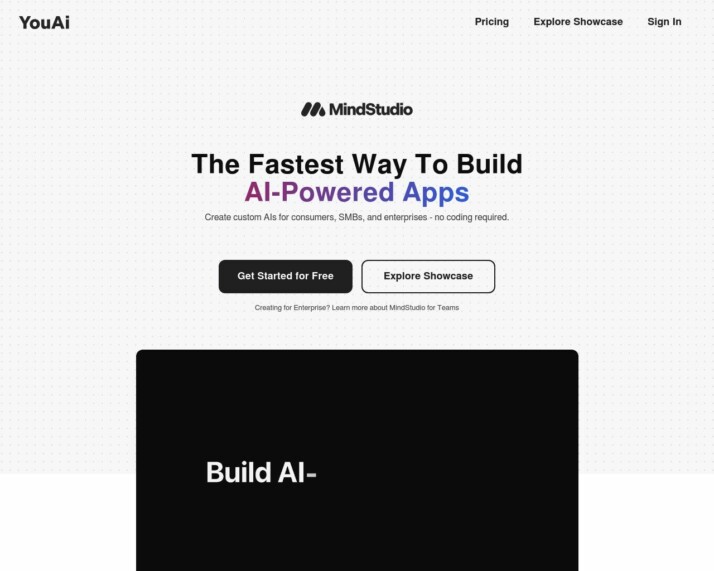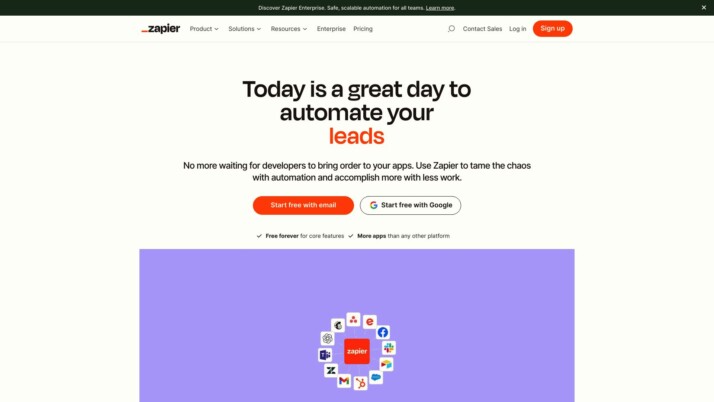You AI/Mind Studio vs. Zapier: Key Differences
As the landscape of artificial intelligence continues to evolve, businesses and individuals alike are seeking powerful and accessible solutions to harness the transformative potential of this groundbreaking technology. This comprehensive guide aims to provide a comprehensive comparison of three prominent platforms, You AI/Mind Studio vs. Zapier, and SmythOS, to empower readers in making informed decisions regarding their AI development and deployment needs.
You AI/Mind Studio Overview
You AI/Mind Studio allows users to create and customize AI agents without the need for coding expertise through its intuitive no-code visual builder interface. This innovative platform caters to a wide range of users, from non-technical enthusiasts to small businesses and content creators, enabling them to build highly personalized AI applications tailored to their specific needs.
One of the standout features of You AI/Mind Studio is its ability to integrate personal data and training prompts, resulting in context-aware AI agents that can provide relevant and customized responses. The platform supports foundational AI models like OpenAI’s GPT-4 and offers a vast array of customization options, allowing users to adjust parameters such as response creativity and length.


Users can publish their AI apps on You AI/Mind Studio and even monetize them by charging subscription fees. The platform provides a comprehensive AI dashboard with analytics and tracking capabilities, offering insights into usage and performance. You AI/Mind Studio supports a wide range of file types, including PDFs, spreadsheets, text documents, and HTML code, allowing for rich data integration to enhance the AI’s capabilities.
Zapier Overview
Zapier is a leading online automation and integration platform that enables users to connect various web apps, SaaS services, and APIs to create automated workflows between them. With pre-built integrations for over 6,000 apps, Zapier allows businesses and individuals to automate repetitive tasks and streamline their processes with no-code workflow builders.
At its core, Zapier acts as a bridge, allowing data and information to flow seamlessly between different applications. Users can create multi-step “Zaps” that watch for triggers in one app and automatically perform actions in another. For instance, a new lead in a CRM system could trigger the creation of a task in a project management tool or the addition of a row in a spreadsheet.


Zapier’s strength lies in its ability to connect a wide range of popular software tools, including G Suite, Slack, Salesforce, and many more. This makes it an attractive solution for small and medium-sized businesses (SMBs) looking to automate and streamline their operations without the need for extensive custom development or coding.
Feature Comparison
Zapier pales in comparison to the robust capabilities offered by You AI/Mind Studio when it comes to AI development and customization. While Zapier excels as an automation and integration platform for connecting various web applications and APIs, it lacks the ability to create and customize AI agents, which is the core focus of You AI/Mind Studio’s offering.
You AI/Mind Studio empowers users to build highly personalized AI agents through its intuitive no-code visual builder interface. This allows for seamless integration of personal data, training prompts, and fine-tuning of AI functionalities, resulting in context-aware and tailored AI experiences. In contrast, Zapier primarily focuses on automating workflows between existing applications and services, lacking the capability to develop and deploy custom AI agents from scratch.
You AI/Mind Studio supports foundational AI models like OpenAI’s GPT-4, enabling users to leverage state-of-the-art language models and customize their responses and behaviors. Zapier, on the other hand, does not offer any AI model integration or customization capabilities, limiting its utility to pre-defined automation tasks.
While Zapier provides a visual builder for creating automated workflows, it lacks the advanced features for developing AI agents that You AI/Mind Studio offers. This includes memory and context management, explainability and transparency tools, and support for multimodal inputs, all of which are crucial for building sophisticated AI systems.
In comparison to SmythOS, both You AI/Mind Studio and Zapier have notable limitations. SmythOS offers a comprehensive suite of AI development features, including visual builders, no-code editors, memory and context management, support for autonomous agents, explainability and transparency tools, debugging capabilities, multimodal inputs, problem-solving capabilities, multi-agent collaboration, and human-AI interaction. SmythOS supports a wide range of AI models, APIs, and data sources, making it a more versatile and comprehensive platform for AI development and deployment.
| You AI/Mind Studio | Zapier | SmythOS | |
|---|---|---|---|
| CORE FEATURES | |||
| AI Agents | ✅ | ❌ | ✅ |
| Memory & Context | ✅ | ❌ | ✅ |
| Human-AI Interaction | ✅ | ❌ | ✅ |
| Problem-Solving Capabilities | ✅ | ❌ | ✅ |
| Autonomous Agents | ❌ | ✅ | ✅ |
| Debug Tools | ❌ | ✅ | ✅ |
| Work as Team | ❌ | ✅ | ✅ |
| SECURITY | |||
| Data Encryption | ✅ | ❌ | ✅ |
| OAuth | ❌ | ✅ | ✅ |
| COMPONENTS | |||
| Foundation AIs | ✅ | ❌ | ✅ |
| Zapier APIs | ❌ | ✅ | ✅ |
| All other APIs/RPA | ❌ | ✅ | ✅ |
| DEPLOYMENT OPTIONS | |||
| Production Domains | ✅ | ❌ | ✅ |
| Deploy as API | ❌ | ✅ | ✅ |
| DATA LAKE SUPPORT | |||
| PDF Support | ✅ | ❌ | ✅ |
Best Alternative to You AI/Mind Studio and Zapier
While both You AI/Mind Studio and Zapier offer innovative approaches to their respective domains, SmythOS emerges as the superior alternative for building and deploying AI agents at scale. SmythOS provides a comprehensive ecosystem that seamlessly addresses the feature gaps present in both platforms.
With its intuitive drag-and-drop interface and extensive integration capabilities, SmythOS streamlines the development of AI agents, enabling users to harness the power of cutting-edge AI models from OpenAI, Anthropic, and Hugging Face, among others. Unlike You AI/Mind Studio’s limited focus on language models, SmythOS supports a wide range of AI technologies, including classifiers, logic gates, and data processing capabilities, empowering users to create truly versatile and intelligent agents.
SmythOS excels in areas where both You AI/Mind Studio and Zapier fall short. It offers robust debugging tools, multi-agent collaboration, and advanced features like memory management and context awareness, essential for building sophisticated AI systems. SmythOS provides unparalleled deployment flexibility, allowing agents to be deployed as APIs, webhooks, chatbots, scheduled tasks, and even as ChatGPT plugins, seamlessly integrating into existing workflows and infrastructure.
With its strong emphasis on security and scalability, SmythOS ensures that AI deployments remain secure, compliant, and capable of handling enterprise-level workloads. Its support for data encryption, OAuth authentication, and IP control mechanisms surpasses the capabilities offered by both You AI/Mind Studio and Zapier, making it an ideal choice for organizations with stringent security requirements.
While You AI/Mind Studio and Zapier cater to specific niches, SmythOS emerges as the clear winner for those seeking a comprehensive and flexible platform for building, deploying, and managing AI agents across a wide range of use cases and industries.
Conclusion
In the rapidly evolving landscape of AI development and deployment, SmythOS emerges as the clear frontrunner, outshining both You AI/Mind Studio and Zapier with its comprehensive suite of features and unparalleled flexibility. While You AI/Mind Studio offers an intuitive no-code interface for building personalized AI agents, and Zapier streamlines automation and integration workflows, neither platform can match the breadth and depth of capabilities provided by SmythOS.
With its visionary approach to AI orchestration, SmythOS empowers users to create, deploy, and manage intelligent agents across a wide range of environments and embodiments. From APIs and webhooks to chatbots and scheduled agents, SmythOS agents can seamlessly integrate into existing workflows and infrastructure, delivering unparalleled value and efficiency.
SmythOS sets itself apart by embracing a multi-agent paradigm, enabling teams of AI agents to collaborate and tackle complex tasks with ease. This collaborative approach, combined with robust debugging tools and explainability features, ensures transparency and accountability, fostering trust in the AI solutions developed on the platform.
Explore the full potential of SmythOS and its extensive ecosystem of 300k+ integrations. Whether you’re a developer seeking cutting-edge AI capabilities, a business leader looking to optimize processes, or a researcher pushing the boundaries of AI, SmythOS offers the tools and flexibility to bring your vision to life. Deploy agents anywhere and unlock new realms of innovation and productivity.
Experience the future of AI development today with SmythOS. Contact us to learn more about our pricing plans and discover how our platform can accelerate your organization’s digital transformation journey.
Last updated:
Disclaimer: The information presented in this article is for general informational purposes only and is provided as is. While we strive to keep the content up-to-date and accurate, we make no representations or warranties of any kind, express or implied, about the completeness, accuracy, reliability, suitability, or availability of the information contained in this article.
Any reliance you place on such information is strictly at your own risk. We reserve the right to make additions, deletions, or modifications to the contents of this article at any time without prior notice.
In no event will we be liable for any loss or damage including without limitation, indirect or consequential loss or damage, or any loss or damage whatsoever arising from loss of data, profits, or any other loss not specified herein arising out of, or in connection with, the use of this article.
Despite our best efforts, this article may contain oversights, errors, or omissions. If you notice any inaccuracies or have concerns about the content, please report them through our content feedback form. Your input helps us maintain the quality and reliability of our information.
